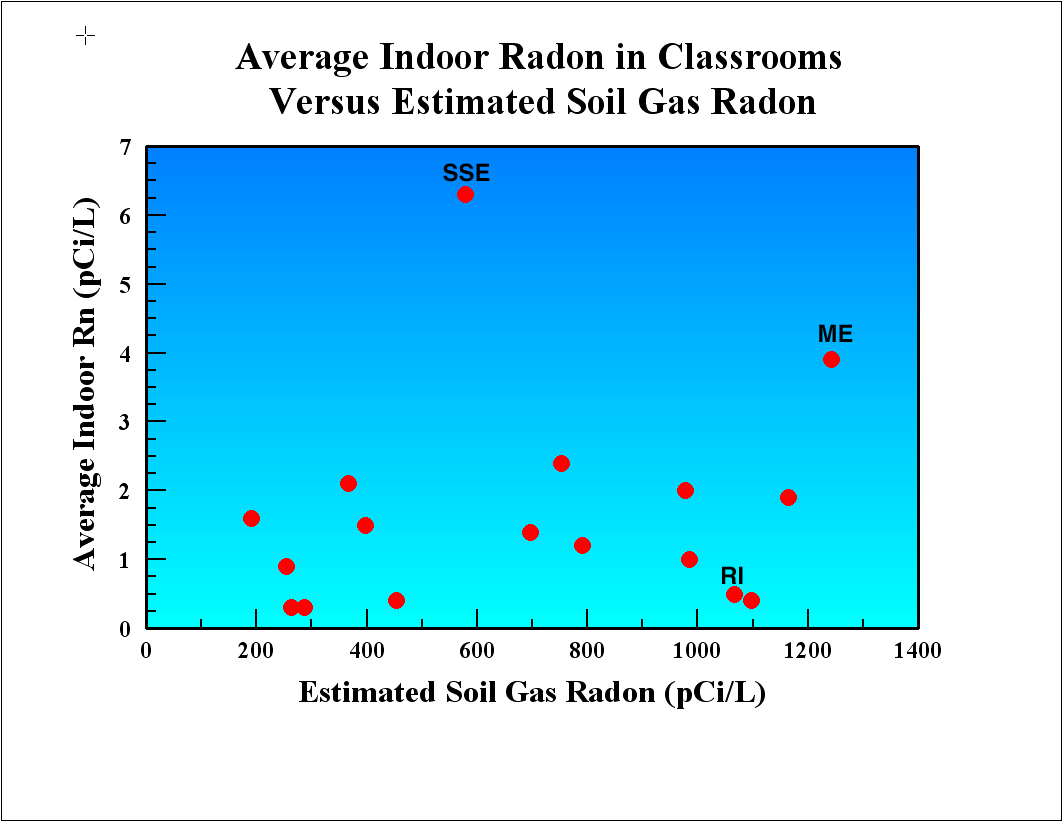
An equation published in UNSCEAR (2000) and based on work by Nazaroff, Moed, and Sextro (1988) and Washington and Rose (1992) provides a means for estimating the amount of radon in soil gas if the radium concentration in the soil minerals, soil moisture, soil porosity, and the fraction of radon that escapes from the soil minerals are known. The equation as given in UNSCEAR (2000) is
CRn = CRa f rs e-1(1-e) (m[KT - 1] + 1)-1
where CRn is the concentration of radon in the soil gas (kBq/m3), CRa is the concentration of radium in the soil (Bq/kg), f is the radon emanation factor, rs is the density of the soil grains (assumed to be 2700 kg/m3), e is the total porosity of the soil including both water and gas phases, m is the fraction that is water filled, KT is the partition coefficient for radon between the water and gas phases. A warm, moist soil (25 oC) will have a value of KT = 0.23 (Washington and Rose; 1992).
We used the analyses of the soil samples collected at the school sites to estimate the radon concentration in the soil gas at those locations. The figure below is a graph of the average indoor radon in the schools versus the average estimated radon concentration in the soil gas. A comparison of this graph to the graph of the average indoor radon versus the uranium concentration shows that the scatter of the points has been reduced. The correlation coefficient has increased to 0.6 and an analysis of variance indicates that a linear relationship is statistically significant at the 99% confidence level. The line shown in the graph is a linear fit to the points and could be used to estimate expected indoor radon at other locations on PalosVerdes Peninsula. We do not suggest that the linear fit will be an absolute predictor for any specific location but that it does estimate the expected average indoor radon level. Previous research (see UNSCEAR; 2000) has shown that building construction is an important factor. Construction factors appear to play a role in the case of Silver Spur Elementary (SSE) and certainly were very important in the case of the 200 Science Wing of Palos Verdes High School. The 200 Science Wing has a crawl space that was excavated through the surface deposit of older alluvium into the phosphatic lithofacies (see the data for Palos Verdes High School for more information). Because of the anomalous character of the 200 Science Wing, indoor radon data from rooms in that wing were not included in the calculation of the average indoor radon.

The data for Silver Spur Elementary (SSE) are anomalous with respect to the data for the other schools. Silver Spur Elementary is also different in the characteristics of the school site in that more than fifty percent of the school grounds are paved. In many places the paved areas completely cover the ground around the buildings. Because of the high indoor radon levels for the amount of uranium in the soil, we suggest that the paved areas may act as a seal or cap preventing the escape of radon into the air and increasing the radon gas content in the underlying soil above what would be otherwise expected.
[an error occurred while processing this directive]